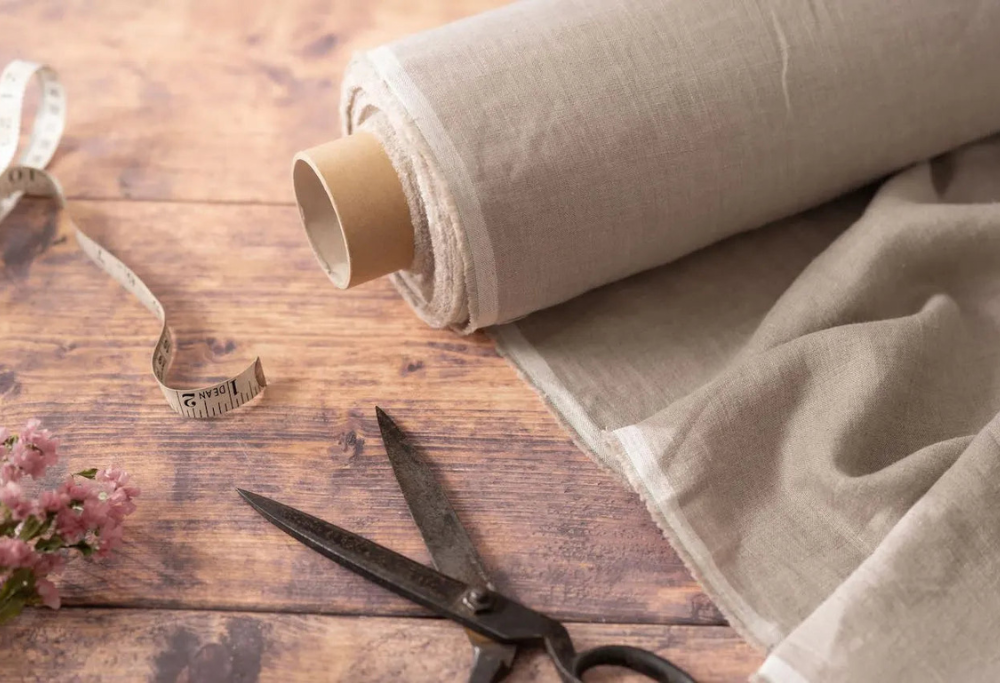When it comes to choosing fabrics for clothing and home textiles, the breathability and comfort of natural fibers are essential considerations. Amongst the array of options, linen stands out as a popular choice. In this blog, we will explore how linen fabric differs from other natural fibers in terms of its unique qualities, including breathability and comfort. From its natural origins to its exceptional properties, we will delve into the world of linen and understand why it is favored by many for its ability to keep us cool, comfortable, and stylish.
Linen
The Natural Cool: Linen, derived from the flax plant, boasts excellent breathability, making it a go-to fabric for warm weather. Its natural fibers are highly absorbent and allow air circulation, enabling heat to escape from the body. This cooling effect sets linen apart from other natural fibers like cotton or silk. Additionally, linen’s lightweight and loosely woven texture contribute to its breathability, ensuring comfort even in hot and humid conditions. Its ability to wick away moisture and dry quickly adds to the overall comfort factor, making it an ideal choice for summer clothing and bedding.
Cotton
Softness and Versatility: Cotton, another popular natural fiber, is known for its softness, comfort, and versatility. While cotton is also breathable, it may not offer the same level of airflow as linen. Cotton fabric tends to retain moisture rather than wicking it away, which can sometimes lead to a less breathable feel in comparison to linen. However, cotton’s wide availability, affordability, and ability to blend with other fibers make it a practical choice for a variety of clothing styles and home textiles.
Silk
Luxurious and Lightweight: Silk, often associated with luxury, offers a unique combination of softness and breathability. Its natural protein structure provides excellent temperature regulation, keeping the body cool in hot climates and warm in cooler temperatures. While silk is renowned for its comfort and smooth texture, it may not be as breathable as linen due to its more tightly woven nature. Silk’s lightweight quality and ability to drape beautifully make it an elegant choice for special occasions and intimate apparel.
Wool
Warmth and Insulation: Wool, a natural fiber sourced from sheep, is primarily known for its insulation properties, making it ideal for colder climates. While wool is not as breathable as linen, its unique structure allows for natural moisture-wicking, keeping the body dry and comfortable. Wool’s ability to regulate body temperature by retaining warmth in cooler temperatures sets it apart from linen. Its cozy and insulating qualities make wool a preferred choice for winter garments, blankets, and outerwear.
Hemp
Eco-friendly and Durable: Hemp, a highly sustainable natural fiber, offers excellent breathability and durability. While it may not be as soft as linen initially, hemp fabric softens over time with wear and washing. Its breathable and moisture-wicking properties make it suitable for warm weather clothing. Hemp’s remarkable strength and resistance to wear and tear contribute to its longevity, making it a durable choice for various textile applications.
Bamboo
Softness and Eco-Friendliness: Bamboo, a sustainable and eco-friendly natural fiber, offers a unique blend of softness and breathability. It possesses natural temperature-regulating properties, making it suitable for various climates. Bamboo fabric is known for its exceptional moisture-wicking ability, keeping the body dry and cool. While not as widely available as other natural fibers, bamboo’s natural antibacterial properties and sustainability credentials have made it a popular choice for those seeking comfortable and eco-conscious clothing options.
Tencel (Lyocell)
Silky Smooth and Moisture-Wicking: Tencel, also known as Lyocell, is a cellulosic fiber made from wood pulp, often sourced from eucalyptus trees. It offers a luxurious silky feel and excellent breathability. Tencel’s moisture-wicking properties help to regulate body temperature and keep the skin dry. Its smooth texture and ability to drape elegantly make it a favored choice for garments that require both comfort and style. Tencel is also celebrated for its eco-friendly production process, using a closed-loop system that minimizes waste and chemical usage, making it a sustainable option for conscious consumers.
Modal
Soft and Drapey: Modal, another cellulosic fiber derived from beech trees, is known for its softness, breathability, and excellent moisture absorption. The fabric offers a smooth and luxurious feel against the skin, making it comfortable to wear. Modal’s breathable nature allows for proper airflow, contributing to a cool and comfortable experience. Its drapey quality makes it suitable for flowing garments and lingerie. While not as widely known as other natural fibers, Modal has gained popularity for its combination of comfort, sustainability, and versatility.
Linen/Cotton Blend
The Best of Both Worlds: Blending linen with cotton creates a fabric that combines the breathability and moisture-wicking properties of linen with the softness and versatility of cotton. This blend offers enhanced comfort, durability, and wrinkle resistance, making it suitable for a wide range of clothing styles. The linen/cotton blend fabric retains the lightweight and breathable qualities of linen while adding the smoothness and ease of care that cotton provides. It strikes a balance between functionality and comfort, making it a popular choice for those seeking a versatile fabric option.
Organic Cotton
Healthier for You and the Environment: Organic cotton is grown without the use of harmful chemicals or pesticides, making it a healthier choice for both consumers and the environment. It offers similar comfort and breathability as conventional cotton but without the potential risks associated with chemical exposure. Organic cotton is hypoallergenic, gentle on the skin, and provides a clean and natural feel.
Advantages of Linen Fabric
Breathability: Linen is highly breathable, allowing air to flow through the fabric, keeping the body cool and comfortable.
Moisture-Wicking: Linen has excellent moisture absorption properties, effectively absorbing and releasing perspiration, keeping the skin dry.
Durability: Linen is known for its strength and durability, making it resistant to wear and tear, and ensuring longevity of garments.
Hypoallergenic: Linen is naturally hypoallergenic, making it suitable for those with sensitive skin or allergies.
Sustainable: Linen is made from flax plants, which require fewer pesticides and water compared to other crops, making it an environmentally friendly choice.
Disadvantages of Linen Fabric
Wrinkles: Linen is prone to wrinkling, and garments made from linen may require ironing or steaming to maintain a crisp appearance.
Stiffness: Linen can initially feel stiff, but it softens with wear and washing over time.
Shrinkage: Linen fabric has a tendency to shrink, especially if exposed to high heat during washing or drying.
Color Fading: Over time, linen fabric may experience color fading, particularly with frequent washing or exposure to sunlight.
Cost: Linen fabric can be more expensive compared to other fabrics due to the labor-intensive production process and the quality of the material.
Conclusion
Linen fabric possesses unique qualities that set it apart from other natural fibers in terms of breathability and comfort. However, various natural fibers, such as cotton, silk, wool, hemp, bamboo, Tencel, Modal, and their blends, also offer distinct advantages. Understanding the characteristics and benefits of these natural fibers allows us to make informed choices based on our preferences and needs.
Frequently Asked Questions(FAQ)
Is linen fabric suitable for hot weather?
Yes, linen fabric is highly breathable and known for its ability to keep the body cool and comfortable, making it an excellent choice for hot weather.
Does linen fabric shrink?
Linen fabric can shrink if exposed to high heat during washing or drying. To prevent shrinkage, it is recommended to follow the care instructions provided by the manufacturer.
Does linen fabric require special care?
While linen fabric may require some extra care, it is relatively easy to maintain. It is best to wash linen in cold water, avoid using harsh detergents, and gently iron or steam to remove wrinkles.
Is linen fabric suitable for people with sensitive skin or allergies?
Yes, linen fabric is naturally hypoallergenic and gentle on the skin, making it a suitable choice for those with sensitive skin or allergies.
Can linen fabric be blended with other fibers?
Yes, linen can be blended with other fibers like cotton or synthetic materials to enhance certain qualities. Blends offer the benefits of both fabrics, such as increased softness or reduced wrinkles.






